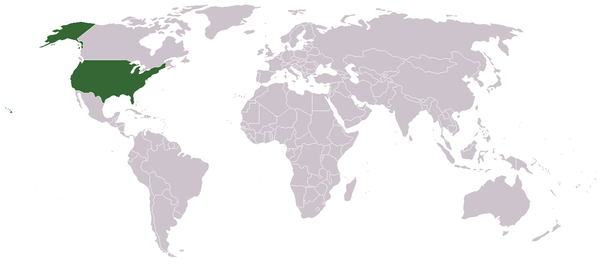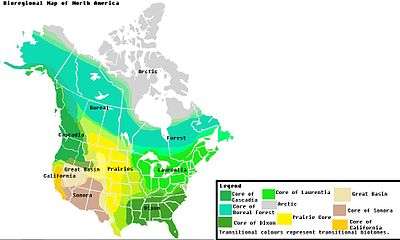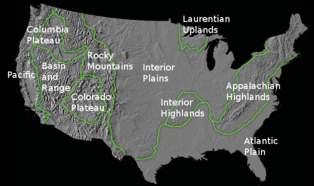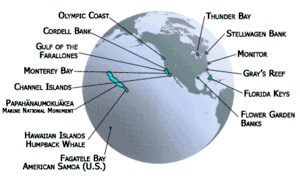Environment of the United States
The environment of the United States comprises diverse biotas, climates, and geologies. Environmental regulations and the environmental movement have emerged to respond to the various threats to the environment.

Biota

Animals
There are about 21,717 different species of native plants and animals in the United States. More than 400 mammal, 700 bird, 500 reptile and amphibian, and 90,000 insect species have been documented.[1] Wetlands, such as the Florida Everglades, are the base for much of this diversity. There are over 140,000 invertebrates in the United States which is constantly growing as researchers identify more species. Fish are the largest group of animal species, with over one thousand counted so far. About 13,000 species are added to the list of known organisms each year.[2]
Fungi
Around 14,000 species of fungi were listed by Farr, Bills, Chamuris and Rossman in 1989.[3] Still, this list only included terrestrial species. It did not include lichen-forming fungi, fungi on dung, freshwater fungi, marine fungi or many other categories. Fungi are essential to the survival of many groups of organisms.
Plants
With habitats ranging from tropical to Arctic, U.S. plant life is very diverse. The country has more than 17,000 identified native species of flora, including 5,000 in California (home to the tallest, the most massive, and the oldest trees in the world).[4] Three quarters of the United States species consist of flowering plants.
Human impacts on biota
The country's ecosystems include thousands of nonnative exotic species that often harm indigenous communities of living things. Many indigenous species became extinct soon after first human settlement, including the North American megafauna; others have become nearly extinct since European settlement, among them the American bison and California condor.[5] Many plants and animals have declined dramatically as a result of massive conversion and other human activity. Humans have impacted the environment through several ways such as overpopulation, pollution, and deforestation.[6]
Climate

The U.S. climate is temperate in most areas, tropical in Hawaii and southern Florida, polar in Alaska, semiarid in the Great Plains west of the 100th meridian, Mediterranean in coastal California and arid in the Great Basin. Its comparatively generous climate contributed (in part) to the country's rise as a world power, with infrequent severe drought in the major agricultural regions, a general lack of widespread flooding, and a mainly temperate climate that receives adequate precipitation.
Following World War II, the West's cities experienced an economic and population boom. The population growth, mostly in the Southwest, has strained water and power resources, with water diverted from agricultural uses to major population centers, such as Las Vegas and Los Angeles. According to the California Department of Water Resources, if more supplies are not found by 2020, residents will face a water shortfall nearly as great as the amount consumed today.[7]
The United States mainland contains a total of nine distinct regional climates. Those include Northwestern region, the High plains, Midwest/Ohio valley region, New England/mid Atlantic, Southeast, Southern region, and Southwestern region. Each region contains different states and has their own climate and temperatures throughout the year.[8]
Geology
The lower 48 states can be divided into roughly five physiographic provinces: the American cordillera, the Canadian Shield, the stable platform, the coastal plain, and the Appalachian orogenic belt. The richly textured landscape of the United States is a product of the dueling forces of plate tectonics, weathering, and erosion. Tectonic upheavals and colliding plates have raised great mountain ranges while the forces of erosion and weathering worked to tear them down. The plate tectonic history of a region strongly influences the rock type and structure exposed at the surface, but differing rates of erosion along with changing climates can also have impacts on the land.[9]

Environmental law and conservation
The nation's major environmental laws were enacted between 1969 and 1980:
- National Environmental Policy Act (1969)
- Clean Air Act (1970)
- Federal Insecticide, Fungicide, and Rodenticide Act (1972)
- Clean Water Act (1972)
- Endangered Species Act (1973)
- Safe Drinking Water Act (1974)
- Resource Conservation and Recovery Act (1976)
- Toxic Substances Control Act (1976)
- "Superfund" Act (1980)
The Endangered Species Act of protects threatened and endangered species and their habitats, which are monitored by the U.S. Fish and Wildlife Service.
Protected areas

The United States maintains national parks as well as other preservation areas, such as the Florida Everglades. There are more than 400 protected sites spread across 84 million acres but very few are large enough to contain ecosystems.
In 1872, the world's first national park was established at Yellowstone. Another fifty-seven national parks and hundreds of other federally managed parks and forests have since been formed.[10] Wilderness areas have been established around the country to ensure long-term protection of pristine habitats. Altogether, the U.S. government regulates 1,020,779 square miles (2,643,807 km2), 28.8% of the country's total land area.[11] Protected parks and forestland constitute most of this. As of March 2004, approximately 16% of public land under Bureau of Land Management administration was being leased for commercial oil and natural gas drilling;[12] public land is also leased for mining and cattle ranching.
Environmental issues
Climate change, species conservation, invasive species, mining, pesticides, and waste are just some of the environmental issues in the United States. Global warming is the greatest cause of impact to the environment. It also impacts human population, for example, increase heat mortality[13]
Conservation
The Nature Conservancy works with public and private partners to ensure our lands and waters are protected for future generations. They work in all 50 states, protecting habitats from grasslands to coral reefs and addressing threats to conservation.[14]
See also
- Ecotourism in the United States
- Great Plains Population and Environment Data Series
- List of Superfund sites in the United States
- MyEnvironment (website)
- National Conservation Exposition
- National Environmental Information Exchange Network
- Timeline of major U.S. environmental and occupational health regulation
References
- "Our Living Resources". U.S. Dept. of the Interior, National Biological Service. doi:10.5962/bhl.title.4172.
- Number of Native Species in United States
- Farr, D.F, Bills, G.F., Chamuris, G.P. and Rossman, A.Y. "Fungi on Plants and Plant Products in the United States". 1252 pp., APS Press, St Paul Minnesota, USA, 1989
- Morse, L. E., Kartesz, J. T., & Kutner, L. S. (1995). "Native vascular plants". Our Living Resources: a report to the nation on the distribution, abundance, and health of US plants, animals and ecosystems. Washington, DC: US Department of the Interior, National Biological Service. pp. 205–209.CS1 maint: multiple names: authors list (link)
- "Pleistocene Megafauna Extinctions". Cpluhna.nau.edu. Archived from the original on March 8, 2010. Retrieved January 31, 2010.
- 10 Ways Humans Impact the Environment. (June 10, 2016). Retrieved June 15, 2017, from http://interestingengineering.com/10-ways-humans-impact-the-environment/
- A World Without Water -Global Policy Forum- NGOs Archived July 12, 2007, at the Wayback Machine
- Regional Climates in the United States March 21, 2018 USA Today
- Geologic Provinces of the United States: Records of an Active Earth Archived January 19, 2017, at the Wayback Machine US Geological Survey.
- Baker, Maverick (2016). "10 Ways Humans Impact the Environment". interestingengineeering.com. Retrieved March 24, 2018.
- "Federal Land and Buildings Ownership" (PDF). Republican Study Committee. May 19, 2005. Archived from the original (PDF) on May 24, 2010. Retrieved June 13, 2006.
- "Abuse of Trust: A Brief History of the Bush Administration's Disastrous Oil and Gas Development Policies in the Rocky Mountain West". Wilderness Society. May 28, 2007. Retrieved June 11, 2007.
- Williams, Gethin; Uhe, Peter; Sparrow, Sarah; Sera, Francesco; Roberts, William; Millar, Richard J.; Frumhoff, Peter C.; L. Ebi, Kristie; Vicedo-Cabrera, Ana M.; Gasparrini, Antonio; Mitchell, Daniel M.; Eunice Lo, Y. T. (June 5, 2019). "Increasing mitigation ambition to meet the Paris Agreement's temperature goal avoids substantial heat-related mortality in U.S. cities". Science Advances. 5 (6, eaau4373): eaau4373. Bibcode:2019SciA....5.4373L. doi:10.1126/sciadv.aau4373. PMC 6551192. PMID 31183397.
- United States of America. (n.d.). Retrieved June 15, 2017, from https://www.nature.org/ourinitiatives/regions/northamerica/unitedstates/index.htm
Further reading
- Neimark, Peninah; Mott, Peter Rhoades (2011). The environmental debate a documentary history, with timeline, glossary, and appendices. Amenia, N.Y.: Grey House Pub. ISBN 978-1-78034-241-2.
- Reed, Daniel. 2009. Environmental and Renewable Energy Innovation Potential Among the States: State Rankings. Applied Research Project. Texas State University.
- Tresner, Erin. 2009. Factors Affecting States' Ranking on the 2007 Forbes List of America's Greenest States. Applied Research Project, Texas State University.
External links
- Environment at the Pew Charitable Trust